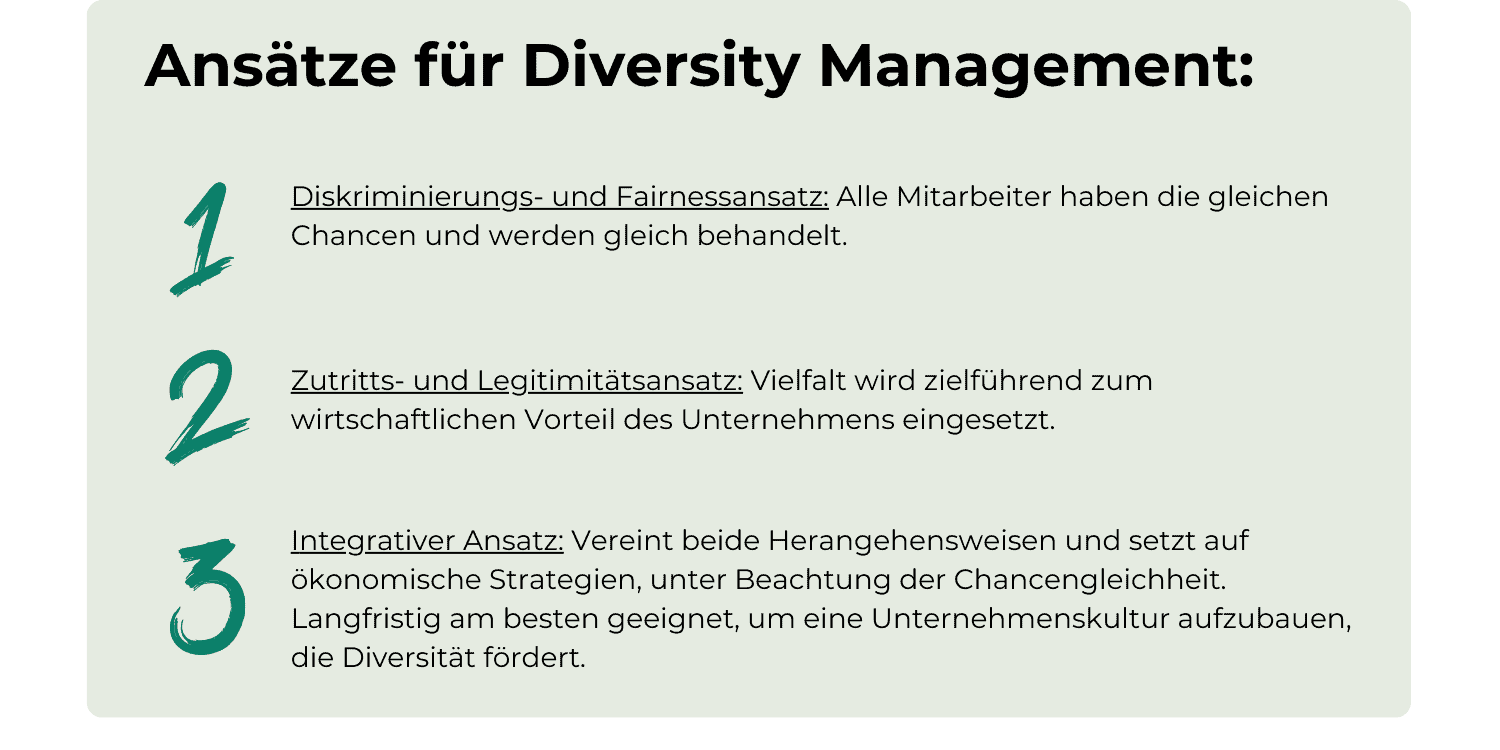
Diverse backgrounds lead to diverse perspectives when looking at problems. It is obvious that this opens up the possibility of recognising a variety of solutions. Companies can therefore make better decisions by putting together diverse teams. For this reason alone, investing in diversity is worthwhile. And this is precisely the crux of the matter in German companies, because: In the area of diversity management, there is still Room for improvement. We explain what is behind the concept of "Diversity Management" and what benefits can be realised for your company.
Diversity management is a specific area of human resources management that aims to actively utilise diversity among employees for the benefit of the company and to achieve corporate goals.
Originally, the main task of diversity management was to prevent discrimination in the application process, particularly on the basis of factors such as physical impairment, ethnicity, gender and age, in order to create equal opportunities.
In recent years, however, this area has evolved. Today, diversity management generally aims to promote equality and diversity in the workplace by valuing and increasing the social, cultural and ethnic diversity of employees. This is achieved through the application of measures and strategies that actively address and enhance this diversity.
The topic has also long since entered the public discourse. Since January 2019, for example, it has been mandatory for job adverts to include people who do not feel they belong to either the male or female gender. When looking for new team members, you should therefore add the "d" for diverse to the classic m/f in your job advertisements. This also corresponds to the General Equal Treatment Act (§ 1 AGG).
In general, diversity management aims to utilise the benefits of different individual competencies, characteristics, skills, attitudes and cultural backgrounds for the success of your company.
Depending on the specific objectives of your company, three different approaches to diversity management can be distinguished:

Companies that are ethnically diverse and inclusive have a 33 % higher success rate and are 1.7 times more likely to become innovation leaders in their industry. They are also more attractive to top talent. According to a Study by Glassdoor 67 % of jobseekers value diversity in the team.
Diversity management is therefore not just a buzzword in general business jargon, but a key strategic element in HR management. Is your company aware that diversity is now far more than just a competitive advantage? It is more than that: diversity is a necessity! Phenomena such as demographic change, the globalisation of markets and digitalisation mean that the customer base of many companies is becoming increasingly diverse and should therefore be addressed in an equally diverse manner.

Your company can not only benefit economically from diversity management. Creating diversity in your company offers many other advantages:
Thanks to different backgrounds, your team is able to identify more potential solutions and master challenges better. This leads to fewer situations that block the organisation.
Different people bring different perspectives to everyday working life. This leads to new ideas and increases the innovative strength of your company. Cultural diversity in particular can be extremely valuable!
Shortage of skilled labour is a problem that is felt everywhere, but if you are open to hiring skilled labour from cultures that have not been considered before, you are at least one step ahead of some of your competitors.
Companies that pursue an open and tolerant strategy and present themselves to the outside world as a diverse organisation tend to receive more applications. This leads to a positive image as an employer and attracts more top talent and high potentials.
Demographic change, globalisation and digitalisation mean that your customers and target groups are also becoming increasingly diverse. In order to continue to fulfil the needs of your customers, it can pay off to be just as diverse internally.
If all employees feel understood and valued within their team, this leads to greater employee satisfaction. This in turn can increase your productivity and thus boost your company's business.
Living diversity can not only increase the satisfaction of your employees, but also their loyalty to your company. In times of a shortage of skilled labour, you can secure talented and well-trained employees for your company. Keyword: Retention management.
Diversity management may be primarily the responsibility of HR, but that does not mean that it can be implemented there alone. Like the topic itself, which is characterised by integration and team spirit, the successful implementation of the diversity approach requires important sparring partners for your HR managers. Essentially, implementation is divided into the following five steps:

The management level, in particular the top management of your company, plays a decisive role in whether diversity is actually implemented in the company. Therefore, make sure that the company management is prepared to review the existing corporate culture and adapt it if necessary. Only if the process is supported by top management and management principles take cultural diversity into account can diversity be successful in the company.
Anchor the new values in clear principles to make them present and measurable. One example of this is the Volkswagen Group, which has set out its commitments to more equal opportunities and diversity in the company in its "TOGETHER Strategy 2025" has anchored.
Before HR managers and company management decide on the implementation of diversity management measures, it is advisable to take a close look at your corporate goals. Which skills are of key importance to your company? How can you grow? What challenges do you face?
If your organisation has a higher than average turnover rate, consider how you can improve the working environment and employee retention and attract the right talent. If you are struggling to connect with international customers, prioritise understanding them better.
Is your product range uninspiring? Then multicultural workshops could help to boost your company's innovative strength.
Get down to the details! Once you have identified the benefits you expect from cultural diversity in your company, it is time to draw up a comprehensive catalogue of measures. The measures can either be taken at a strategic level or designed directly as offers for your workforce. The following ideas can promote your company's success in terms of diversity:
Ensure that responsibilities within and outside the HR department are clearly defined! For example, your recruitment department should focus on reviewing the recruitment processes and ensure that job advertisements are formulated free of discrimination.
Language courses or the implementation of measures to promote diversity in management tend to fall within the remit of HR development. On the other hand, creating a position for an equal opportunities officer or adapting the company's own communication strategy are tasks for management.
Did your efforts bear fruit? You can use various key figures to determine this. For example, ask about the satisfaction of your team and customers. Check the staff turnover rate compared to before the measures. See how various offers are accepted by your workforce.
Additional measures that can be implemented as part of diversity management include, for example, the barrier-free design of workplaces - including from a technical perspective. Here, it is particularly important to focus on software that everyone in the team can use equally well. From simple working time recording to sophisticated project management, you can rely on our ZEP software solution, for example.


Read article ↗

How can you strengthen your employer brand and attract the best talent? Discover 11 effective employer branding measures that will help you stand out from the competition and optimise your recruitment strategy.
Read article ↗
We answer your questions quickly & competently. Contact us by phone or email.
+49 7156 43623-0 or contact form